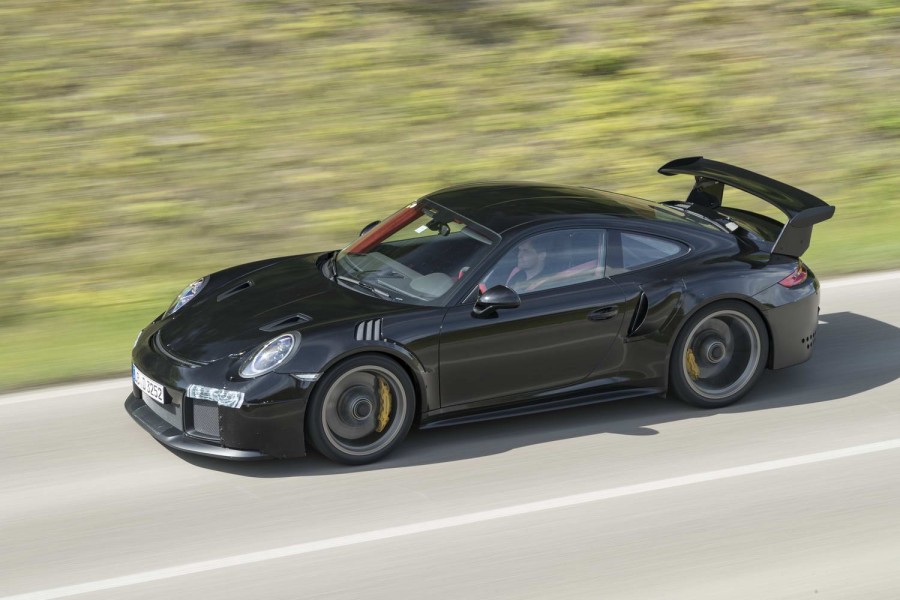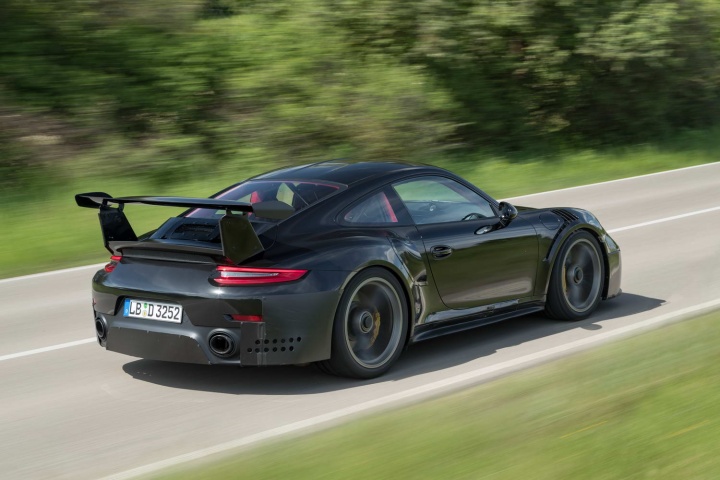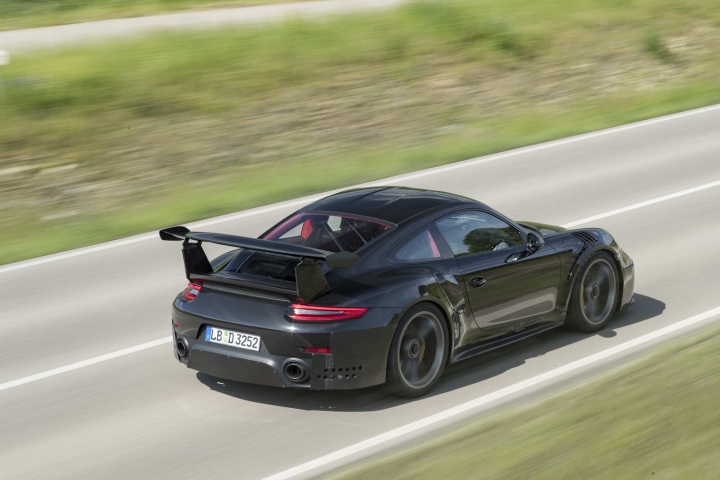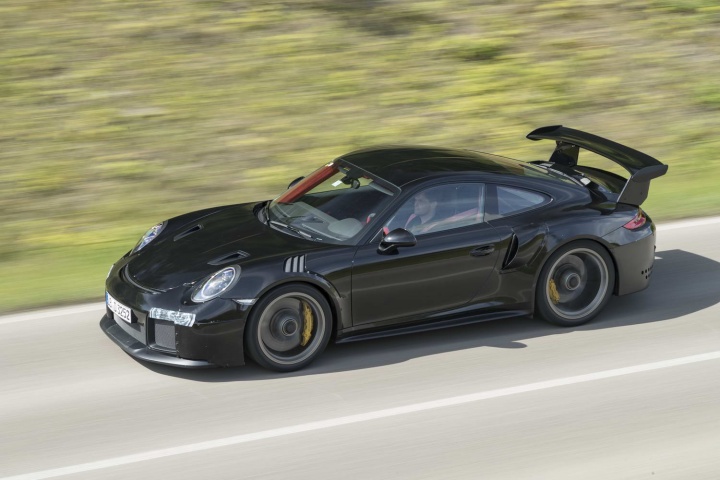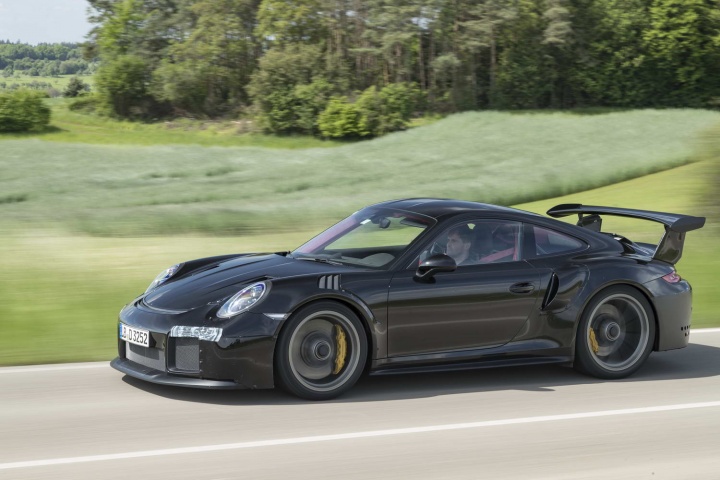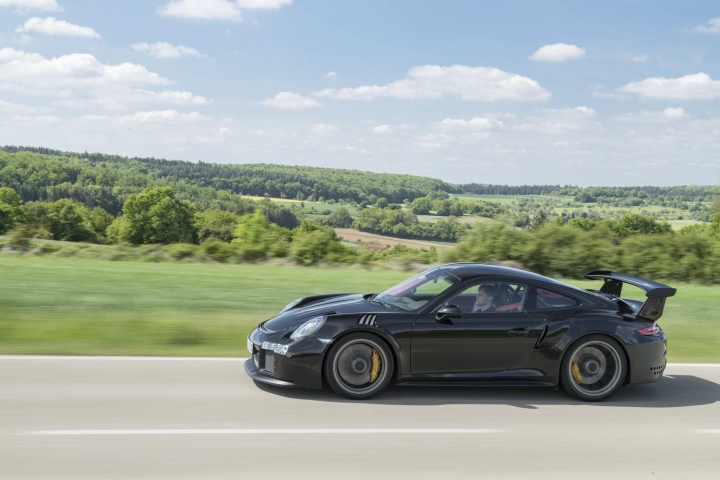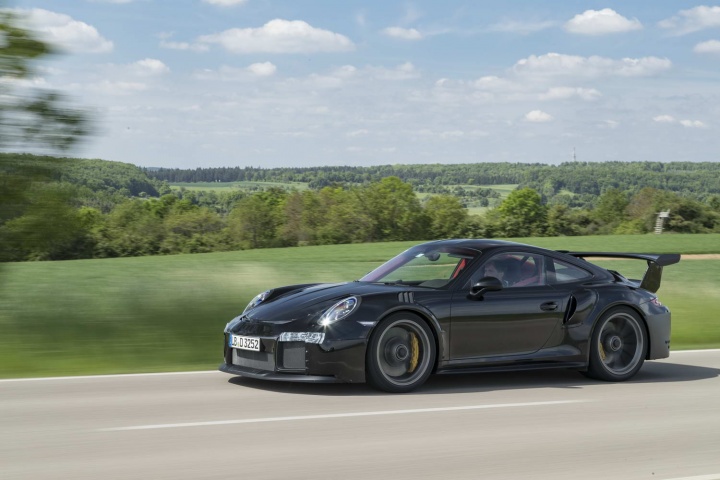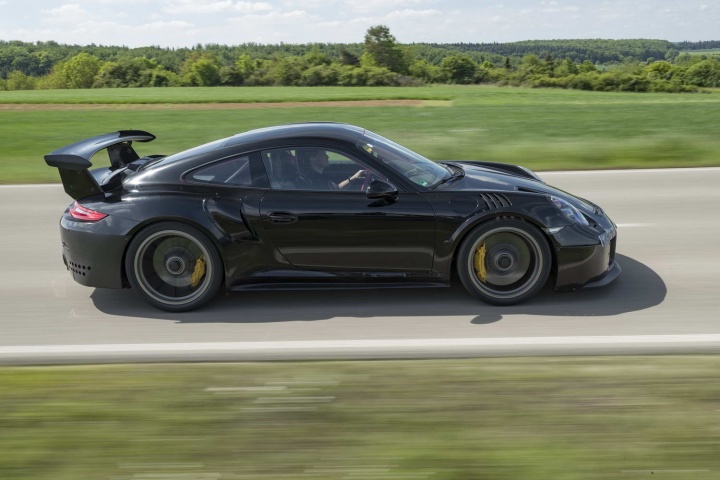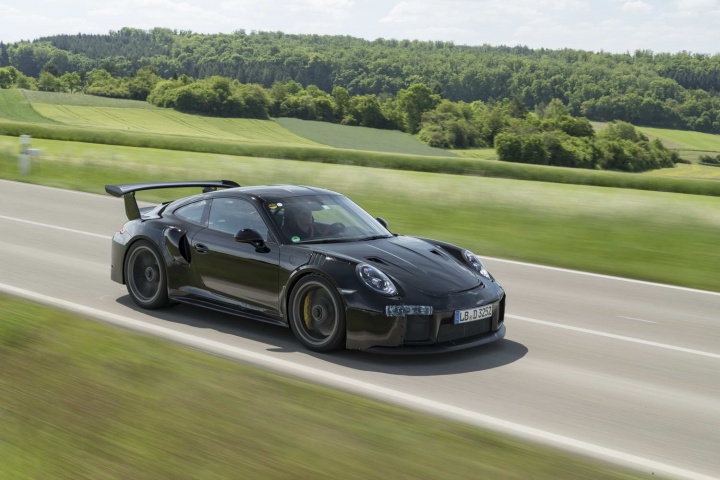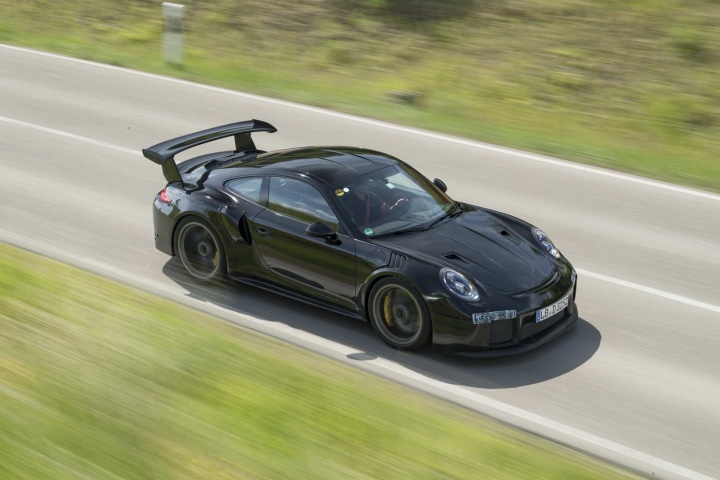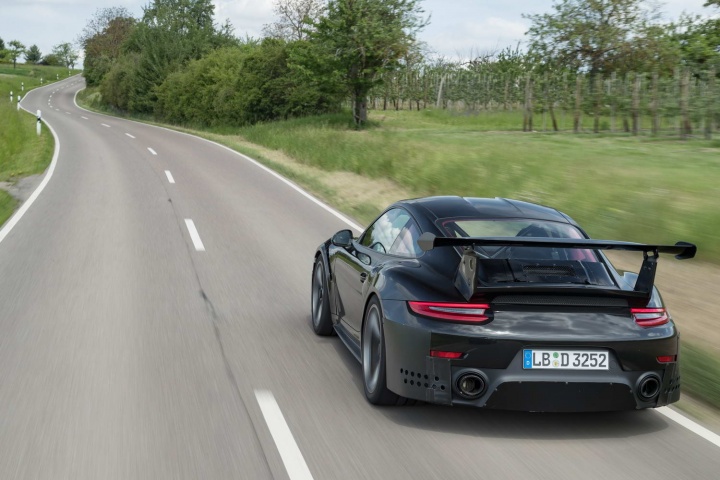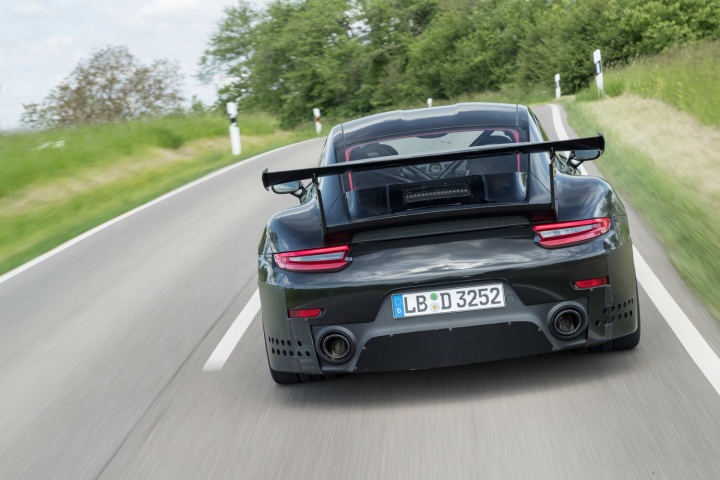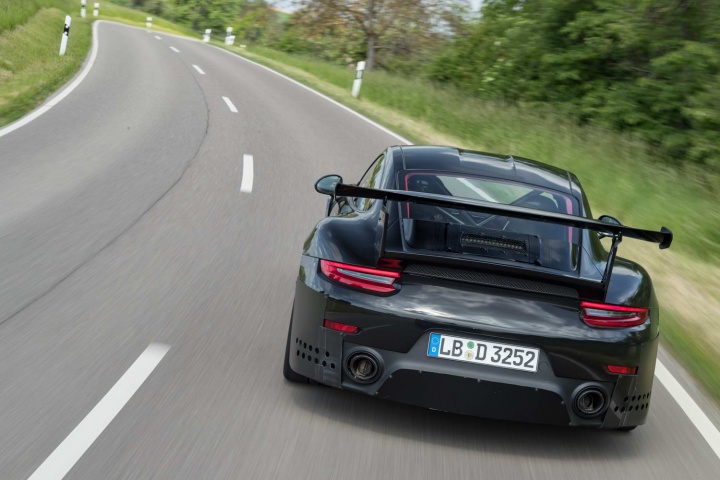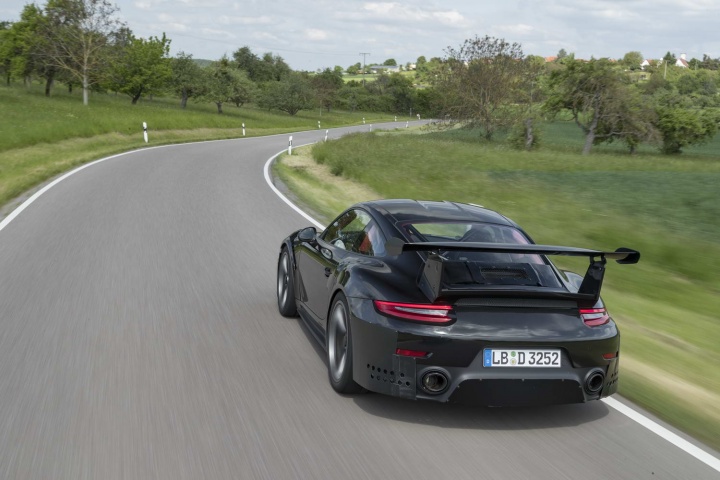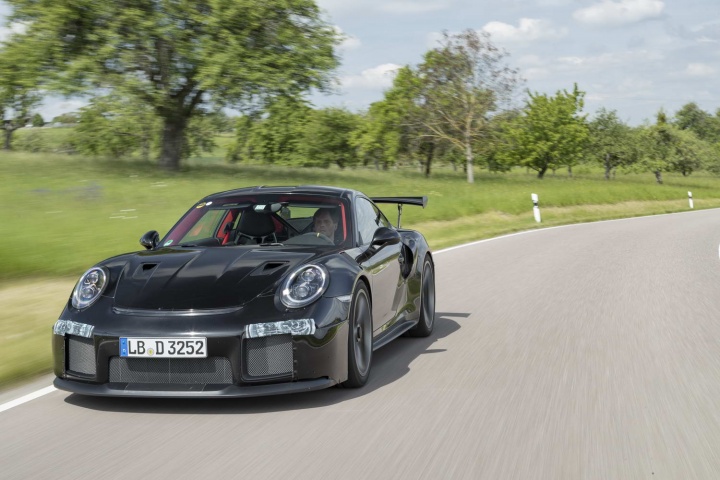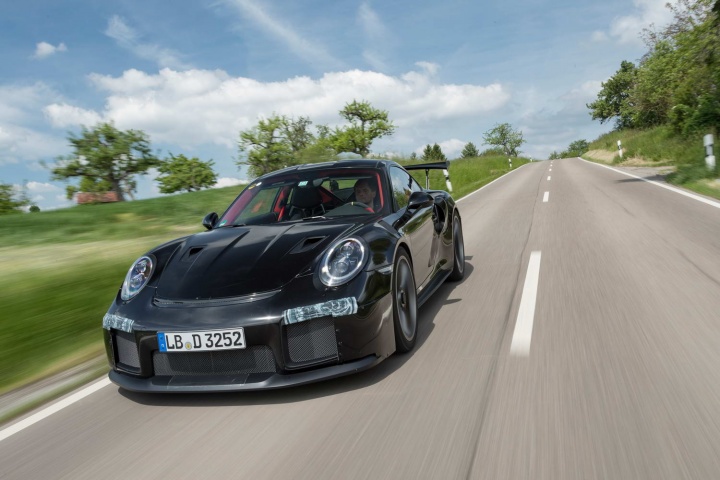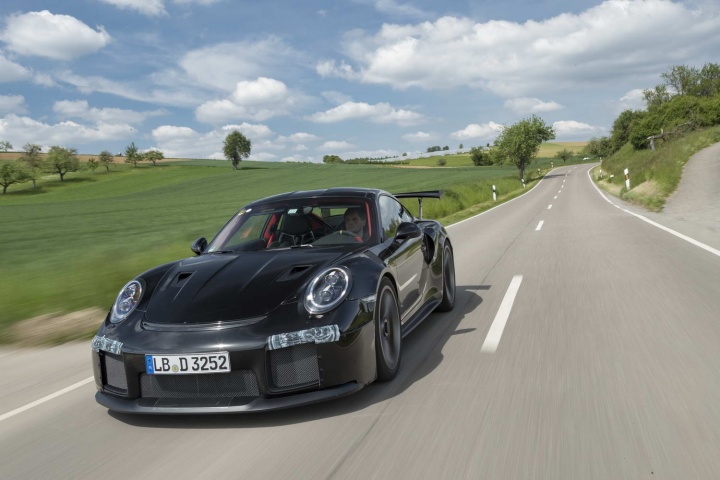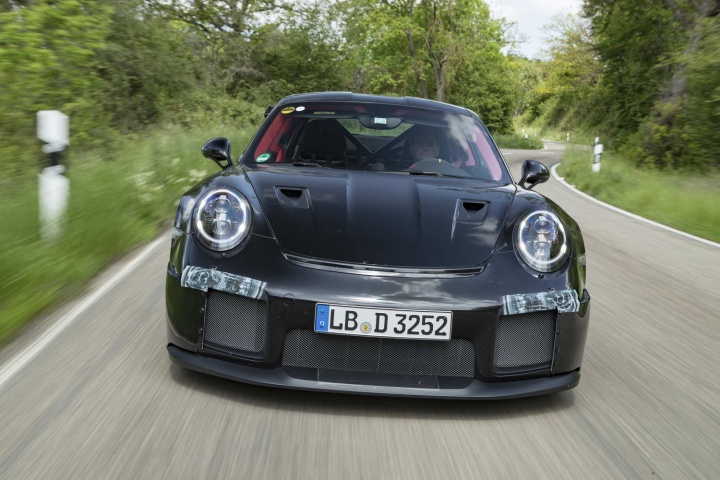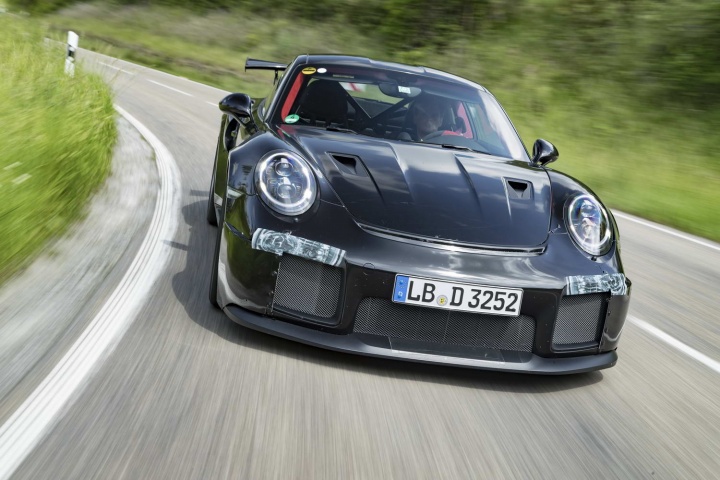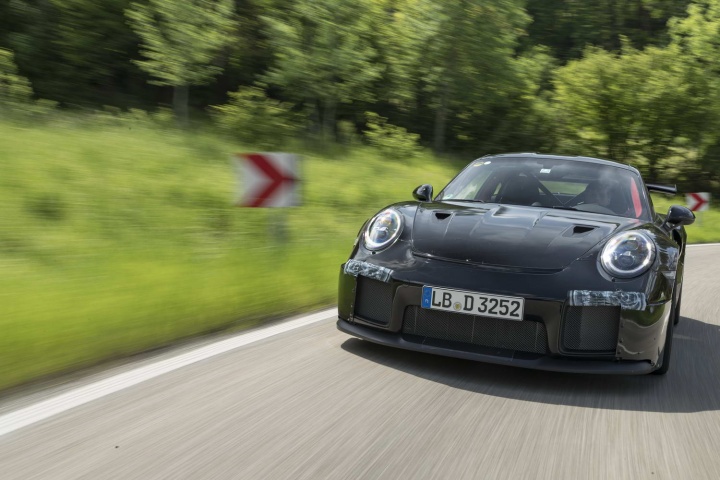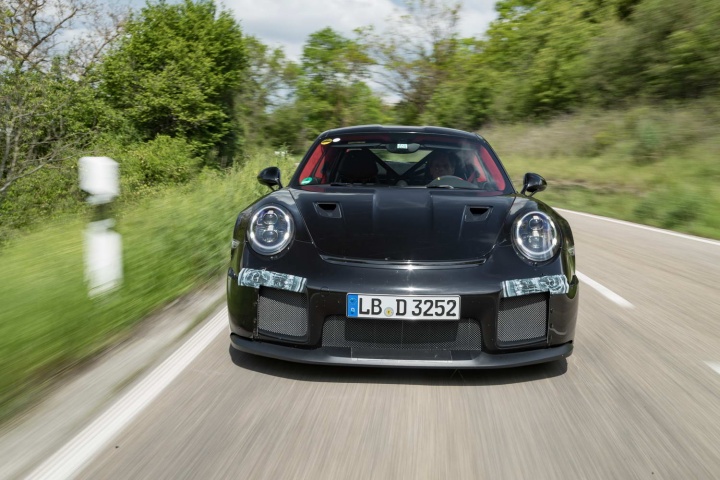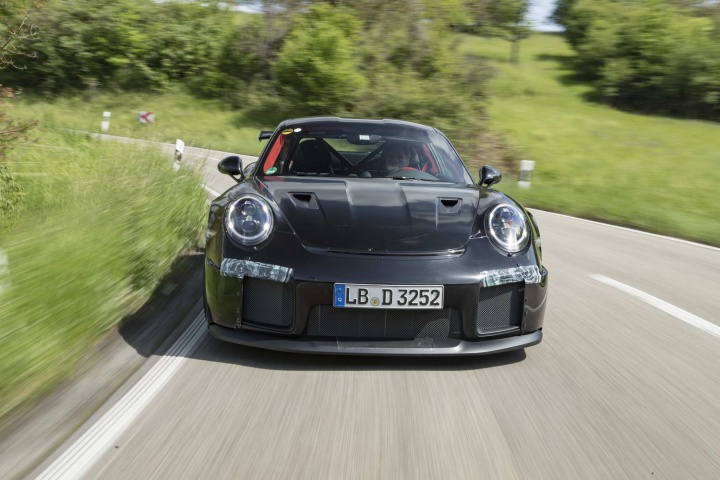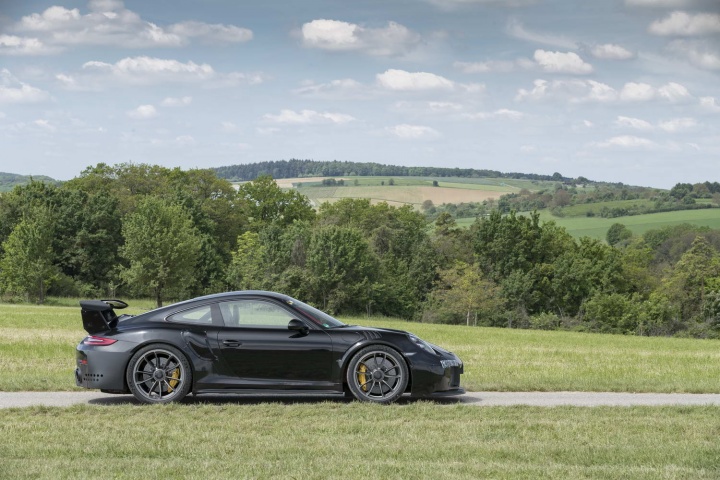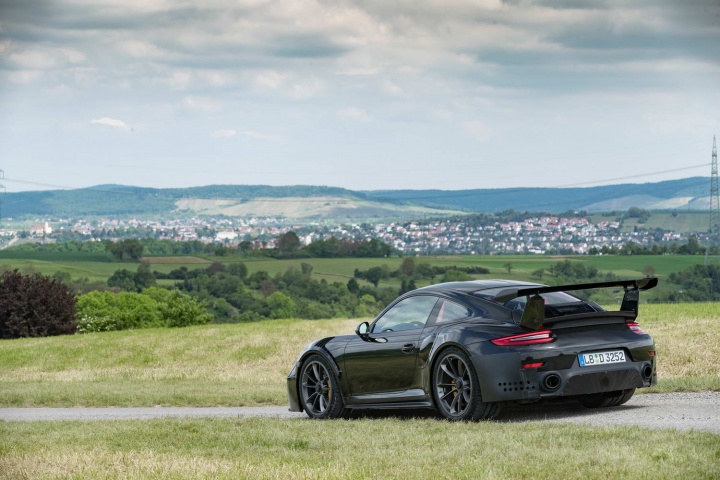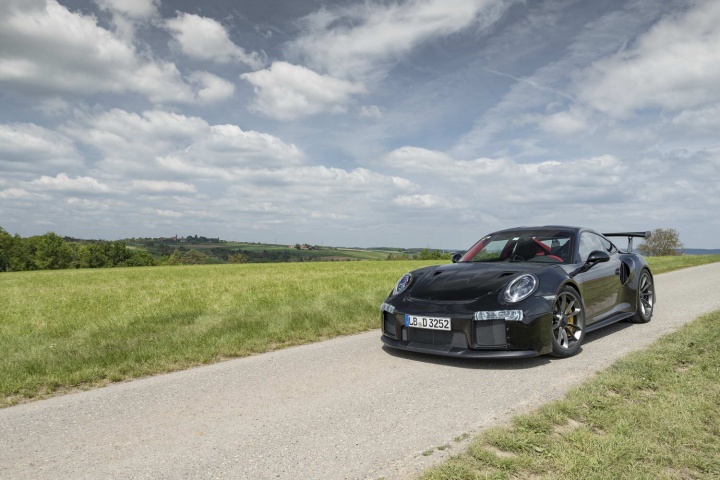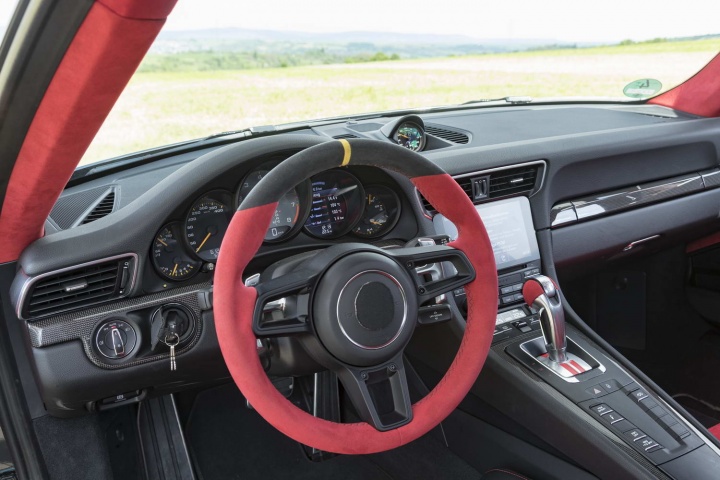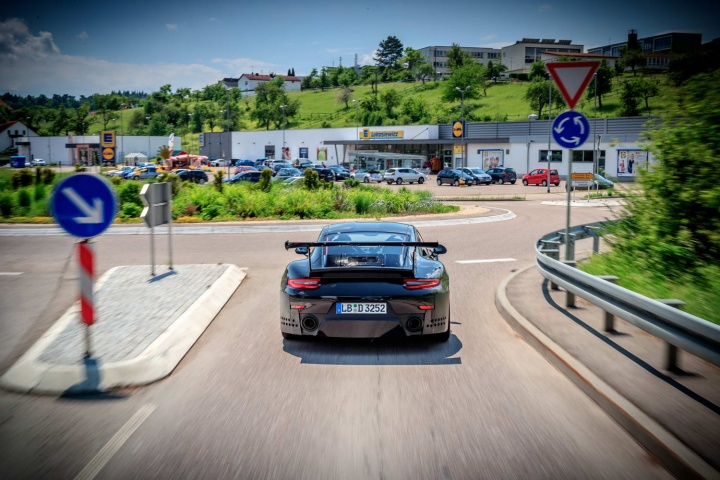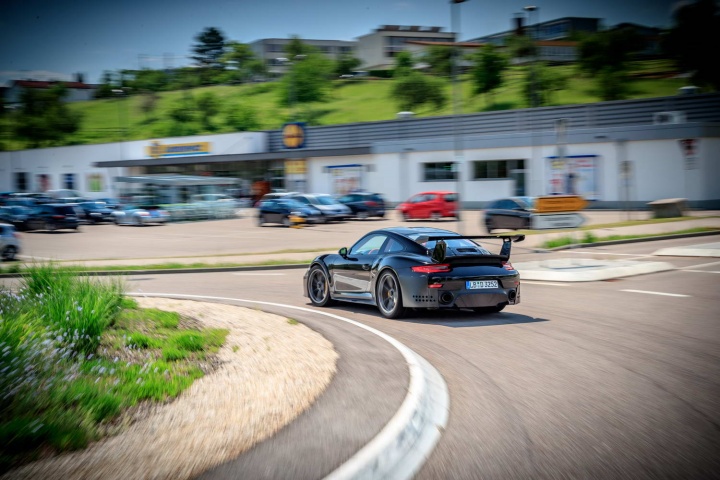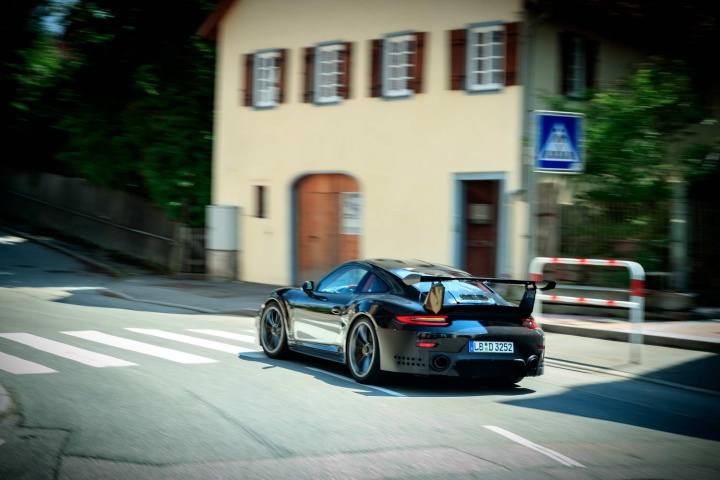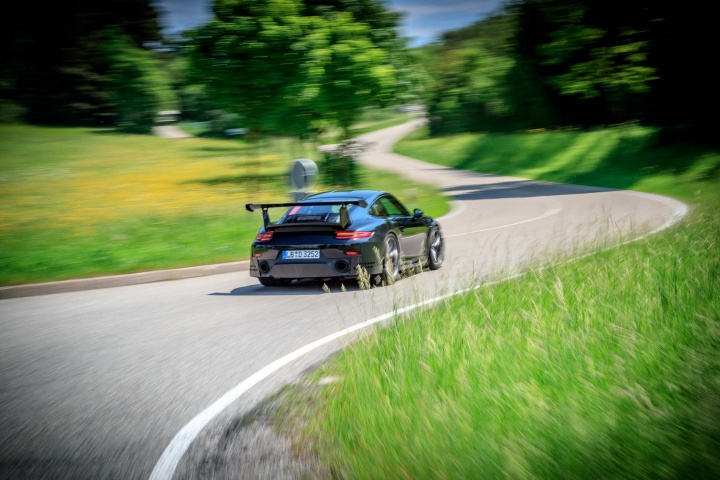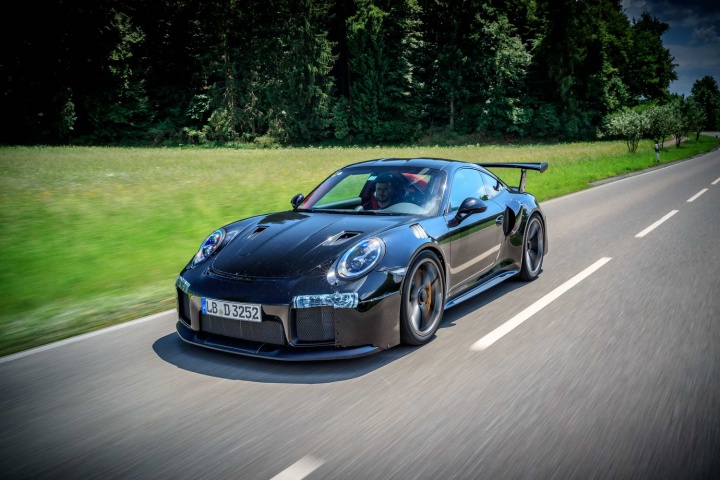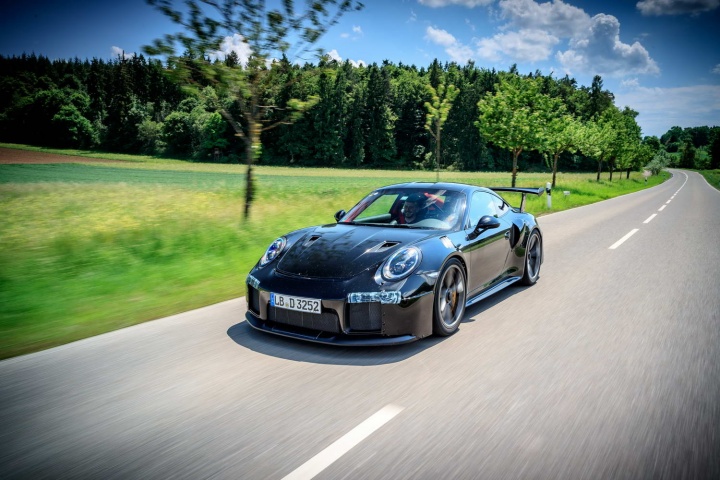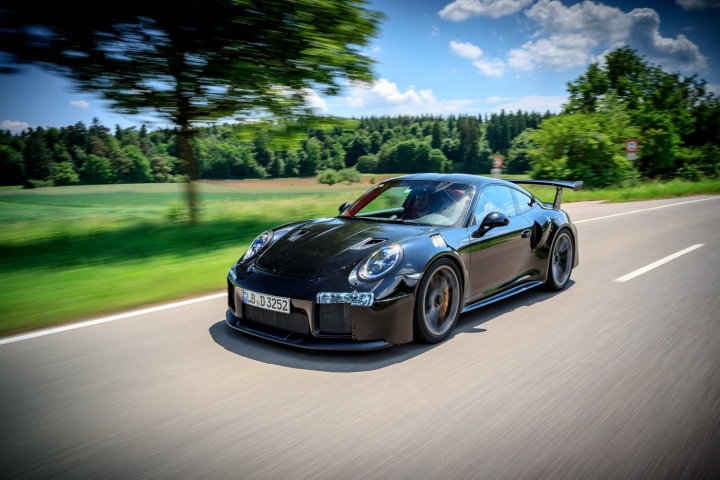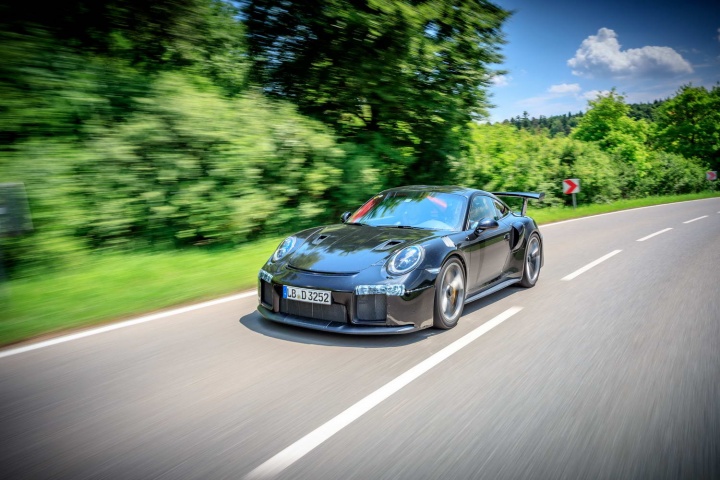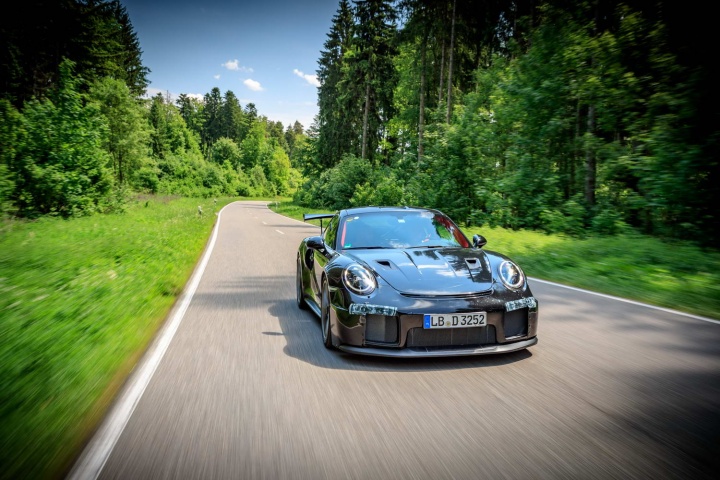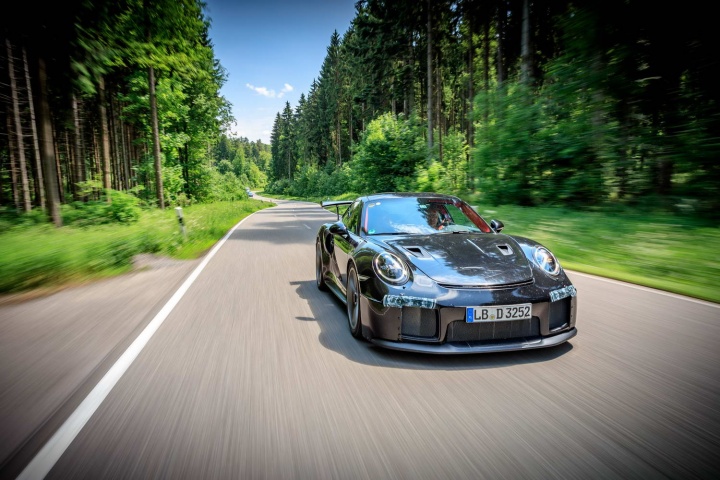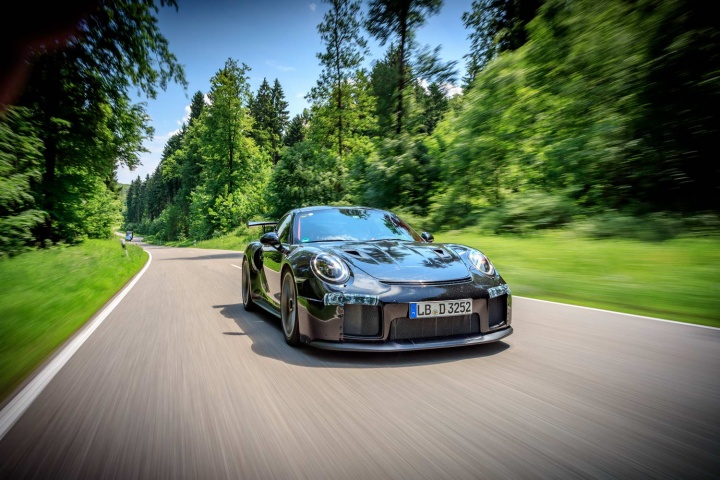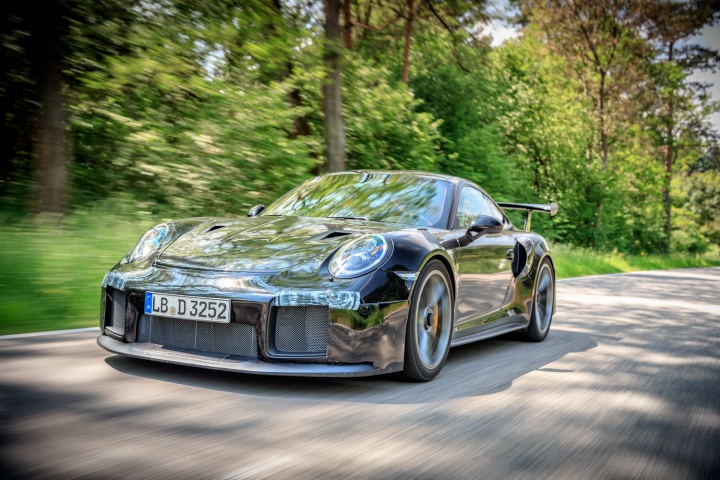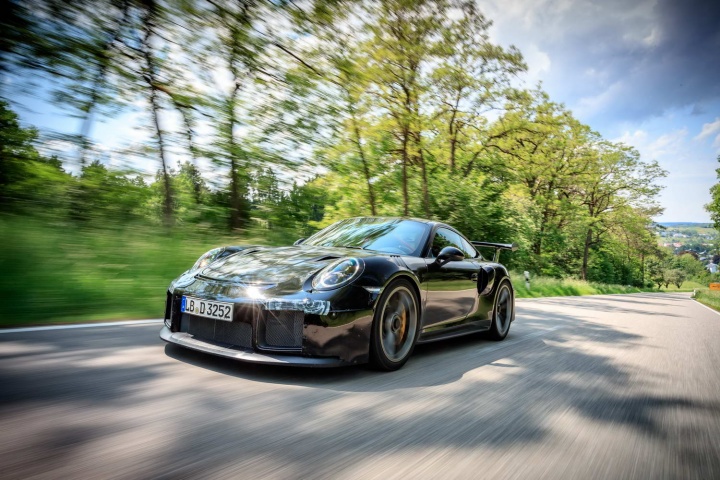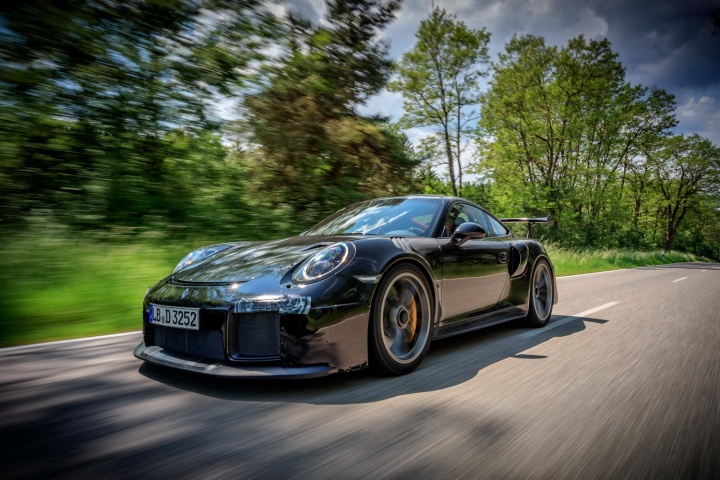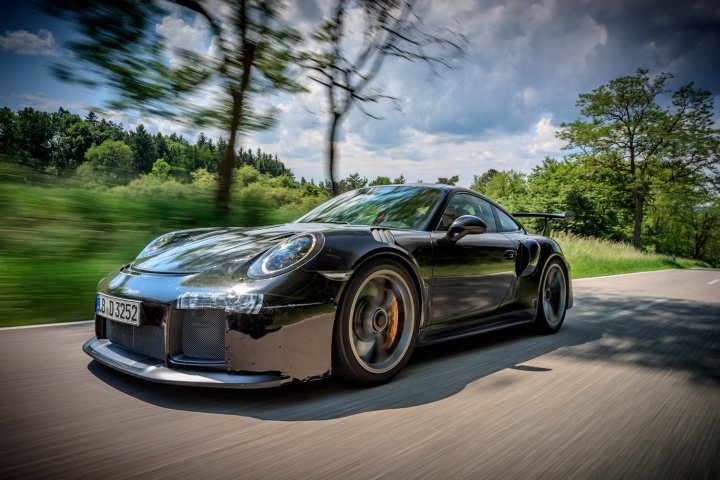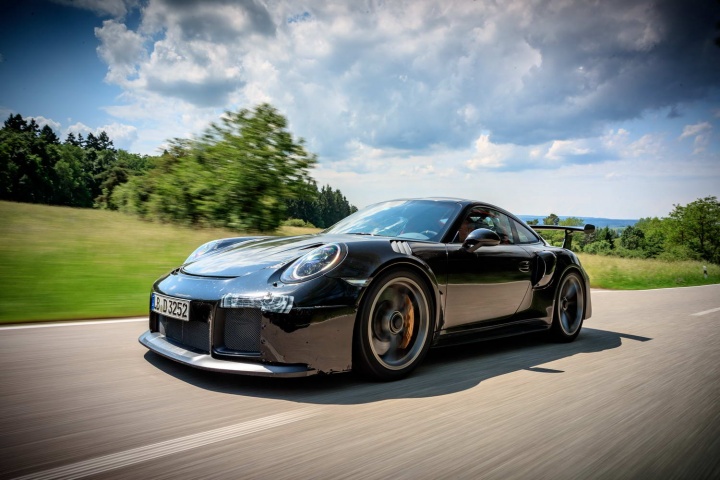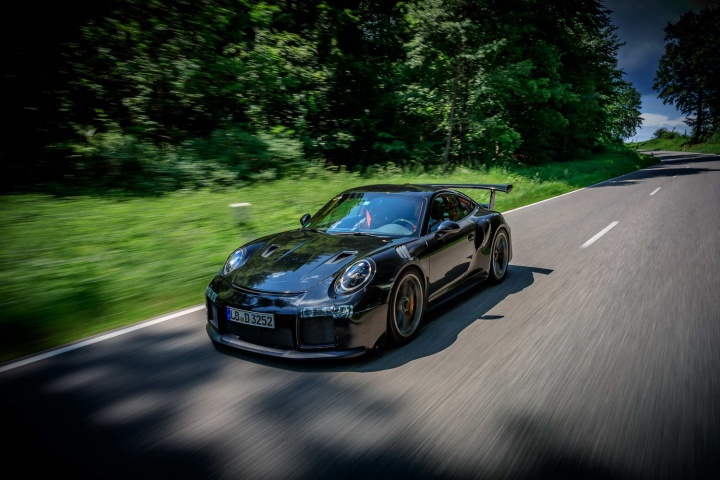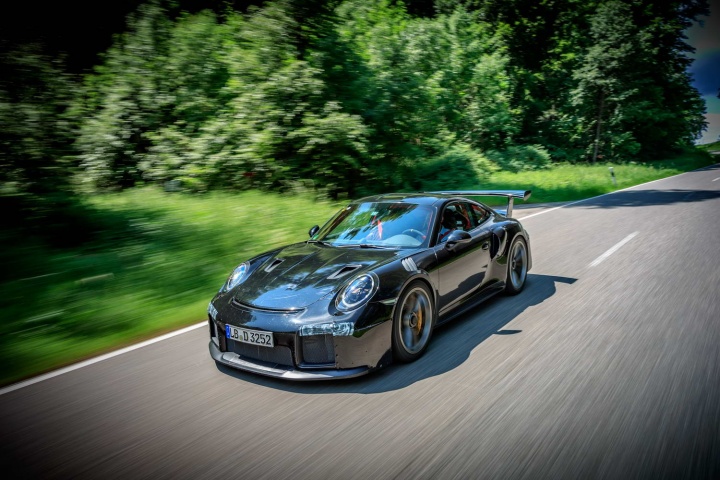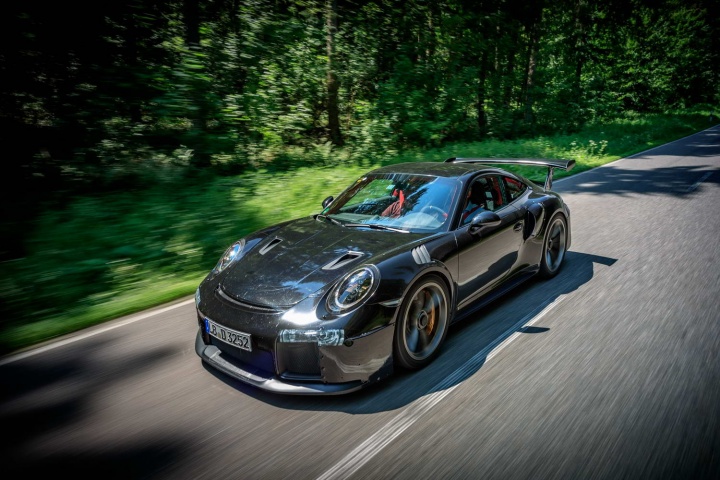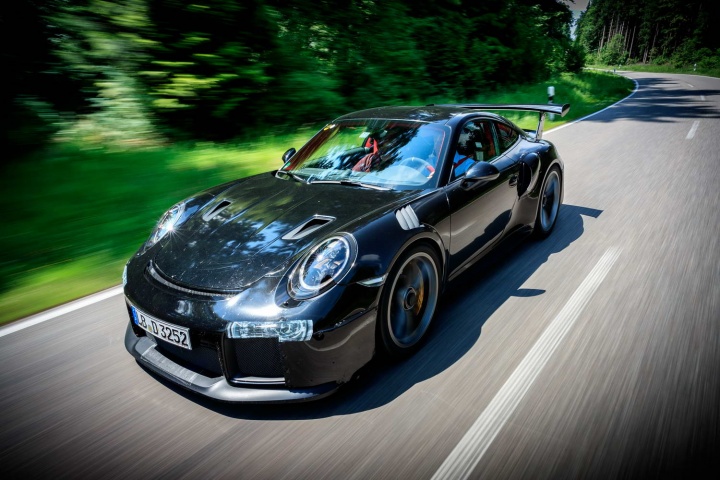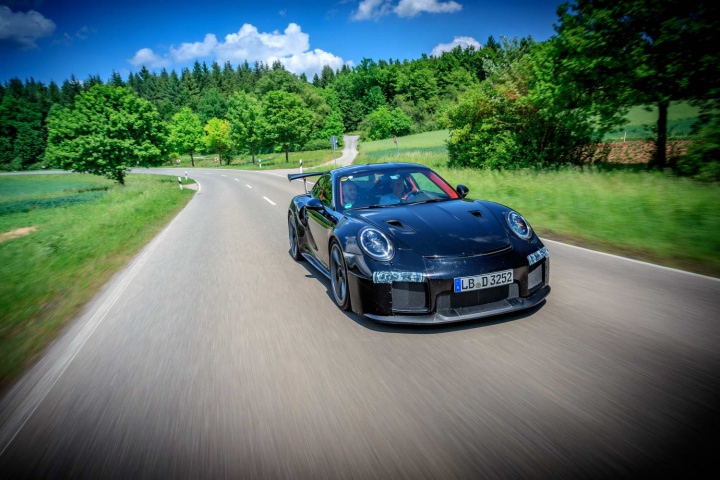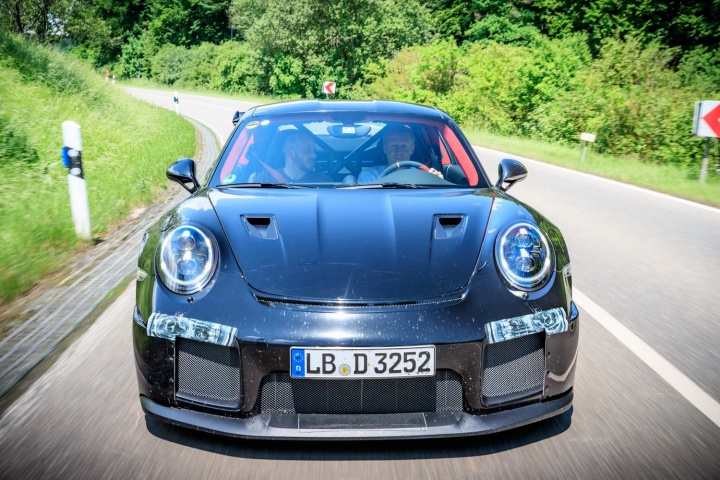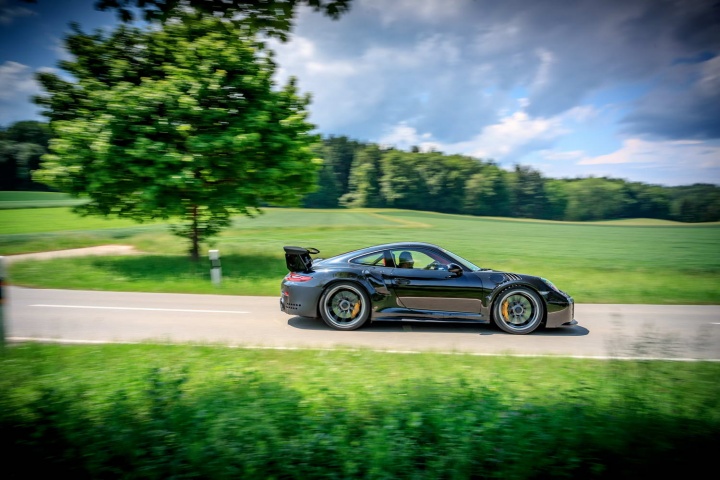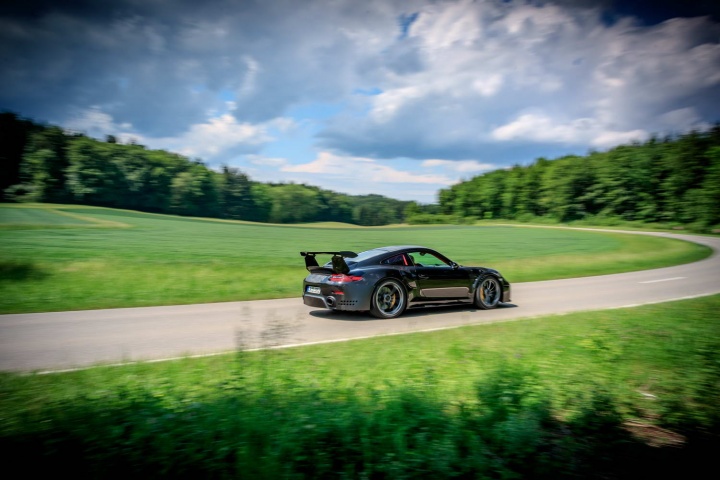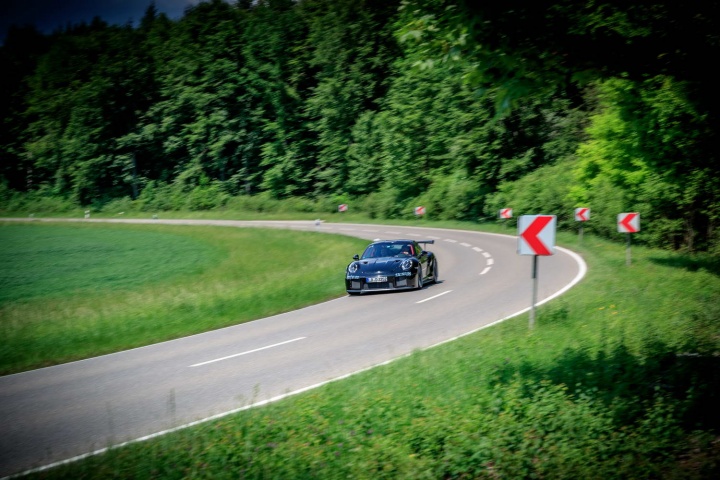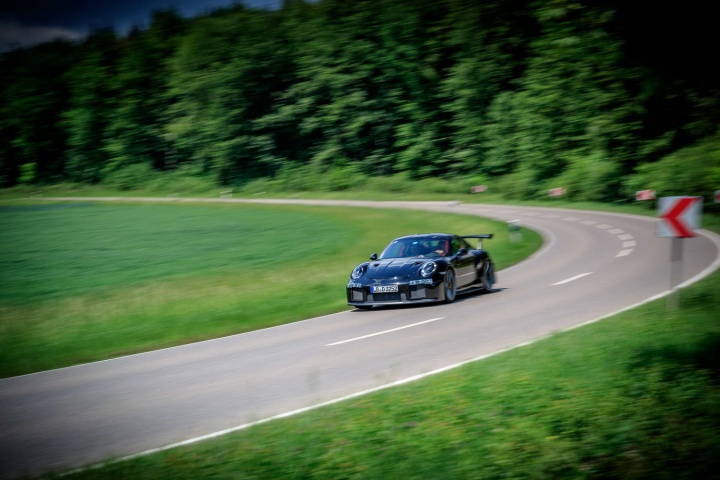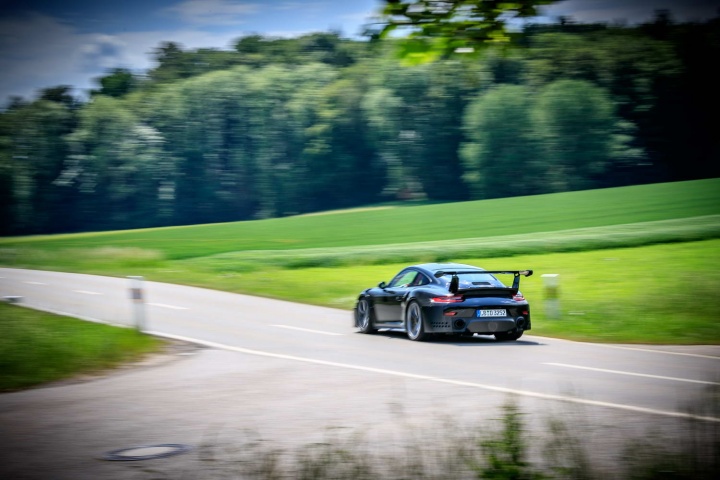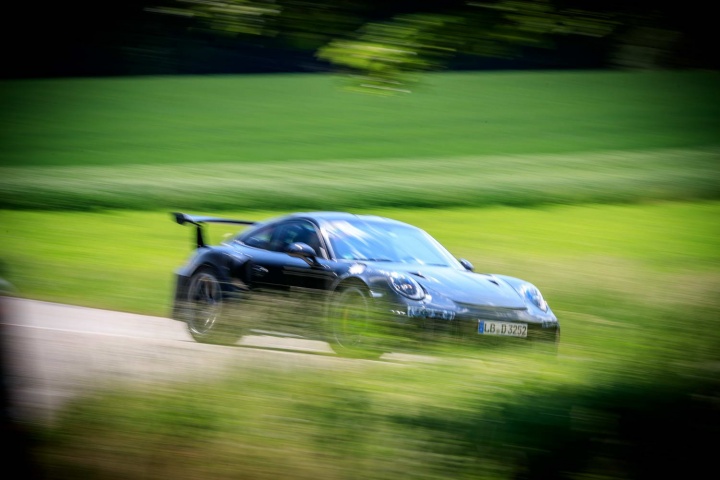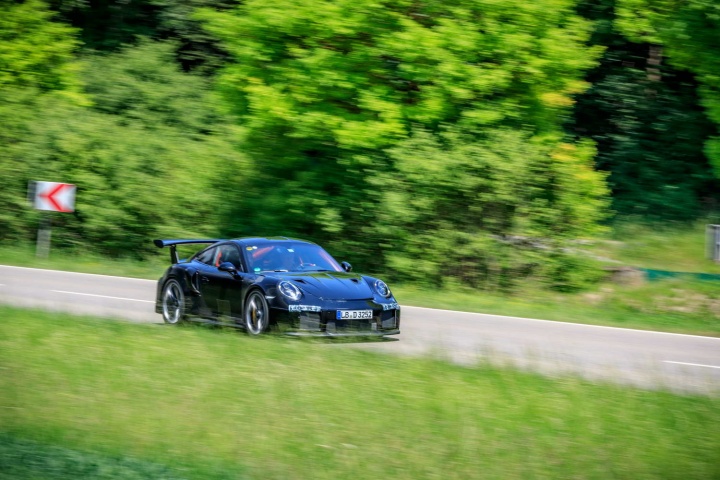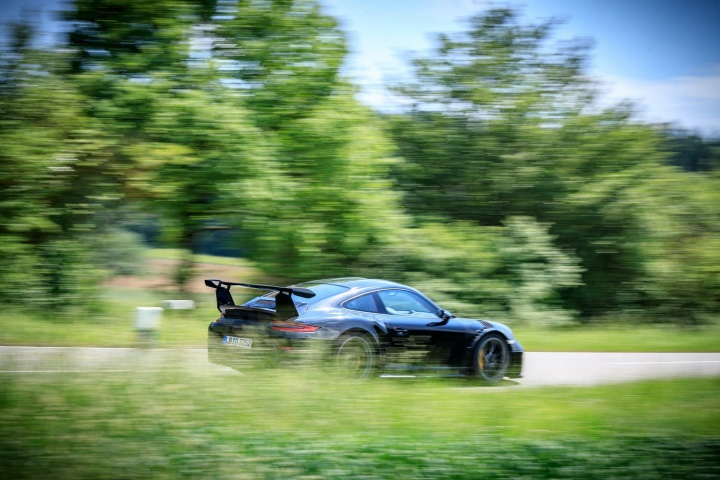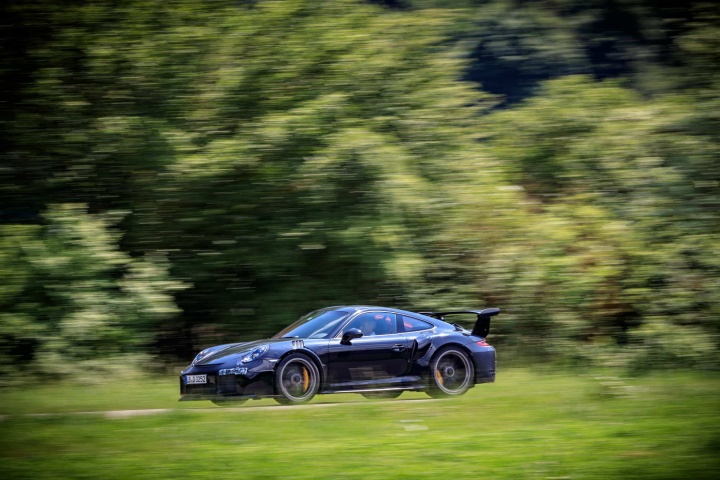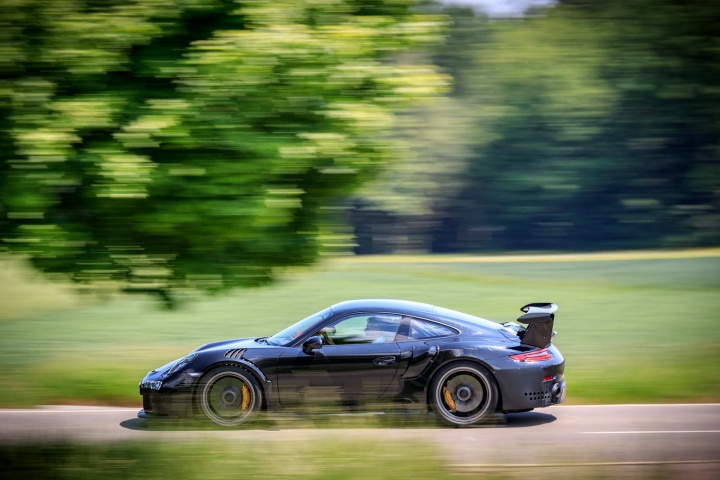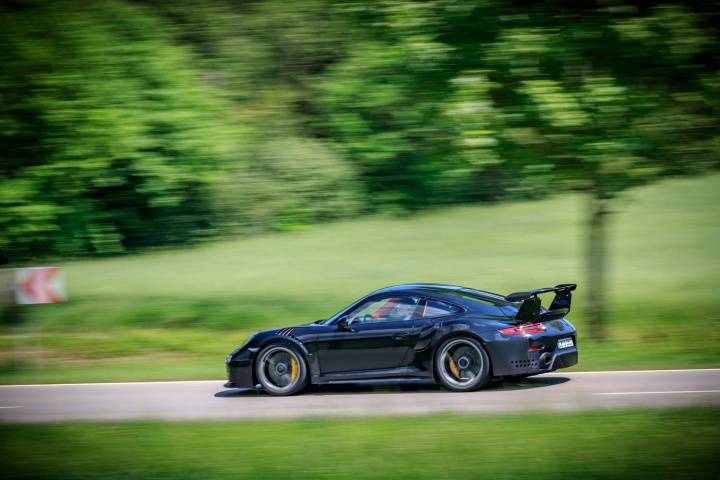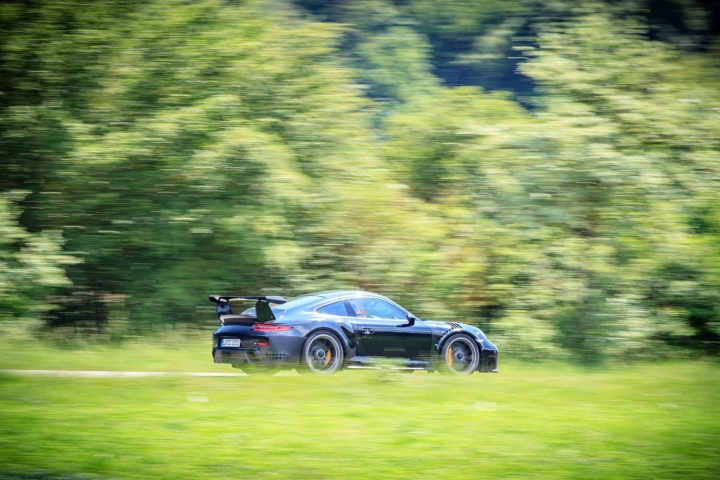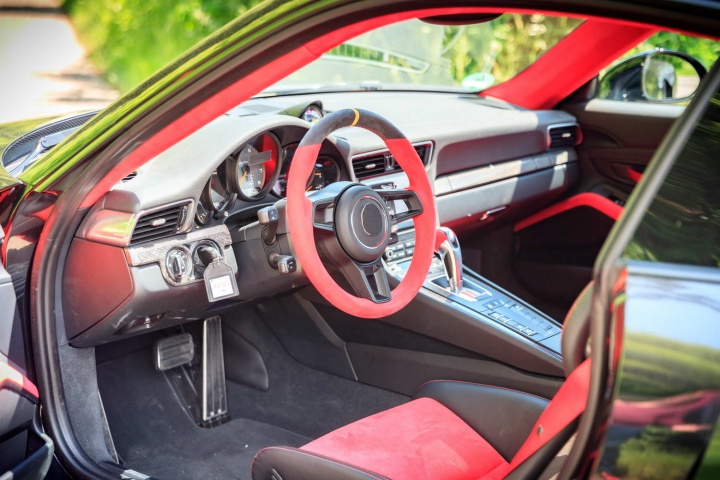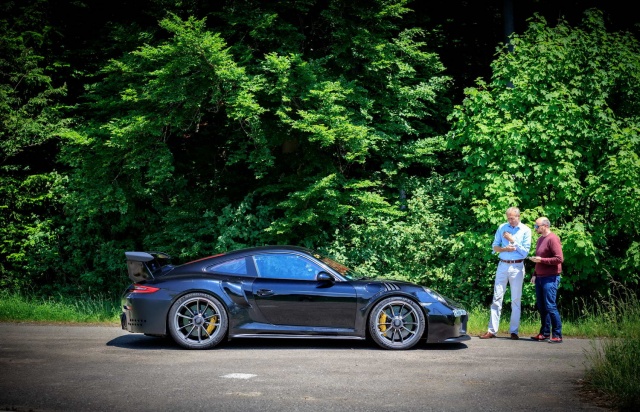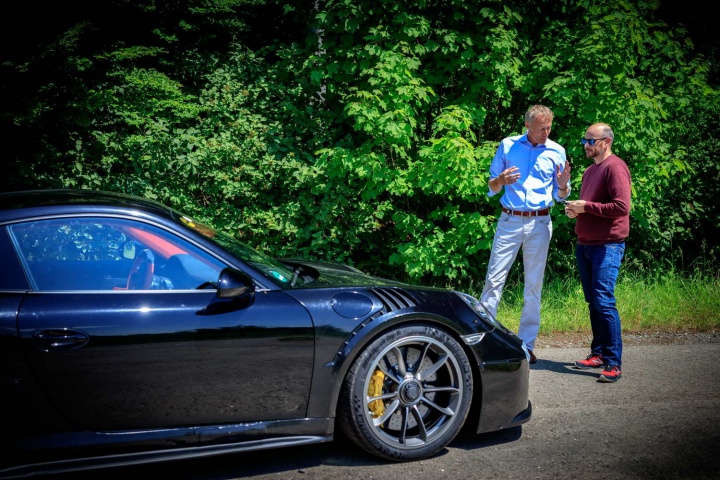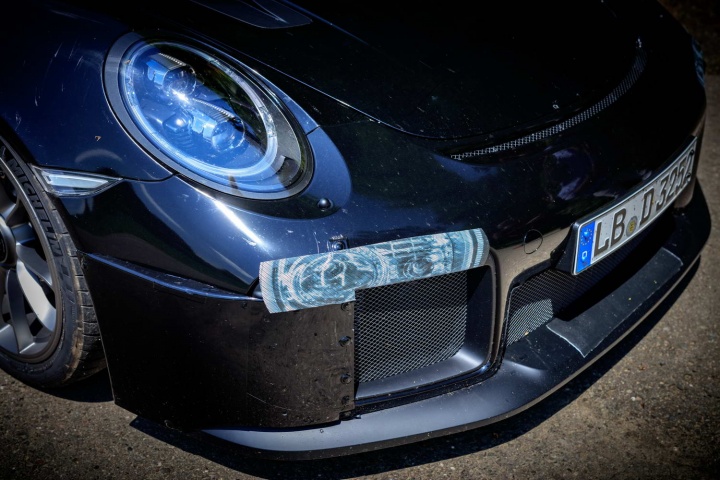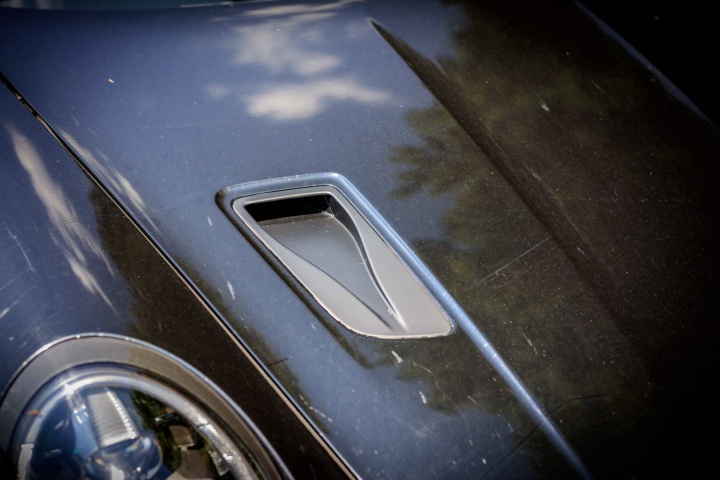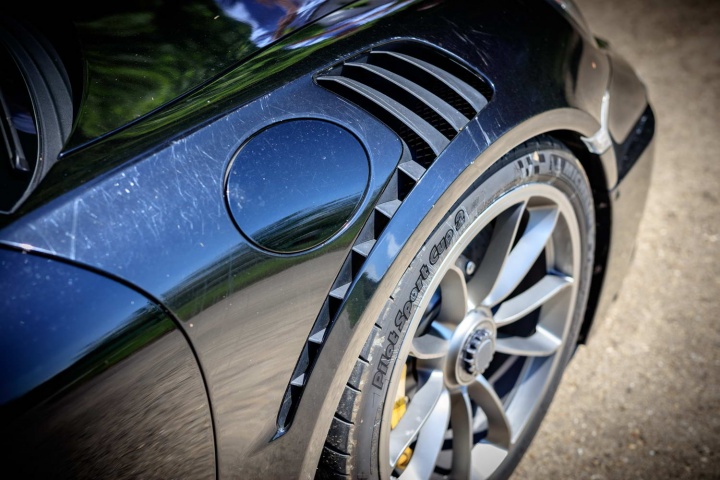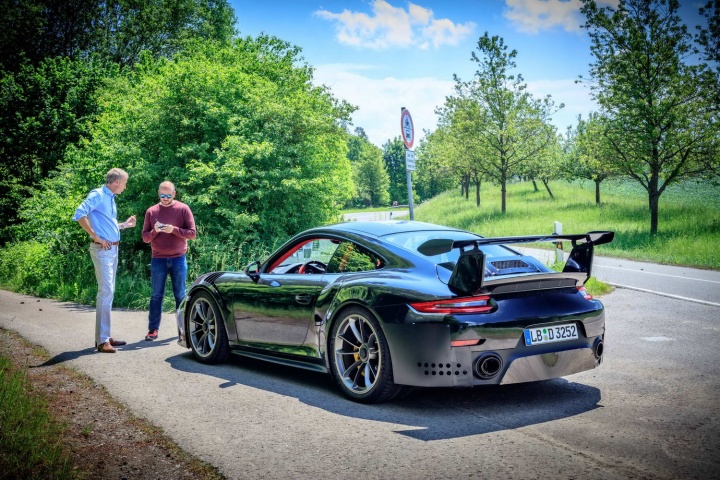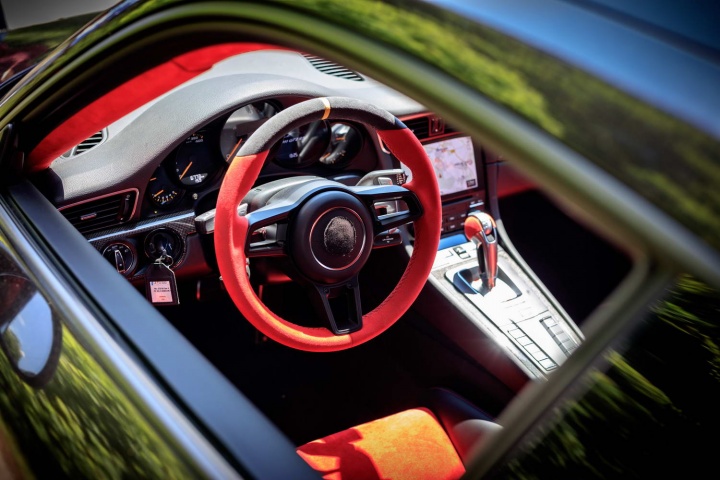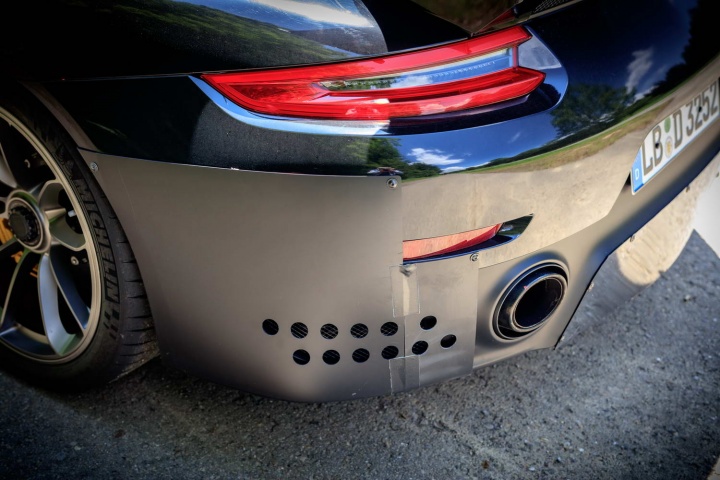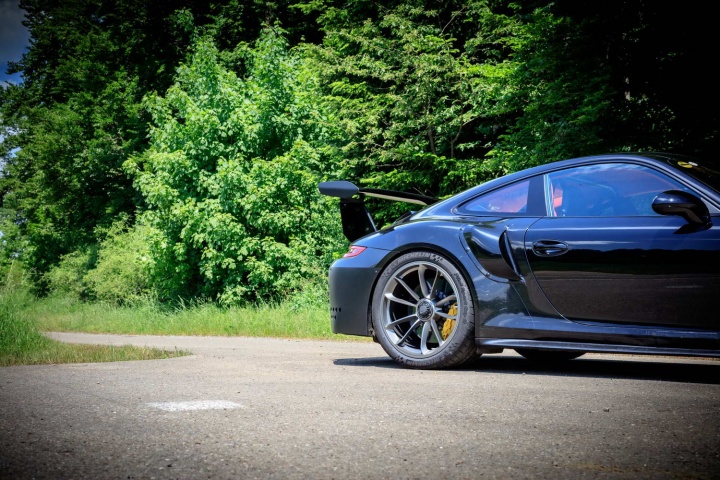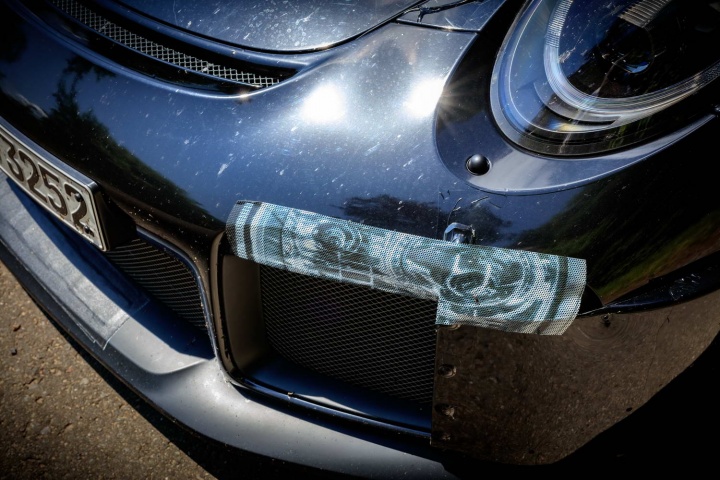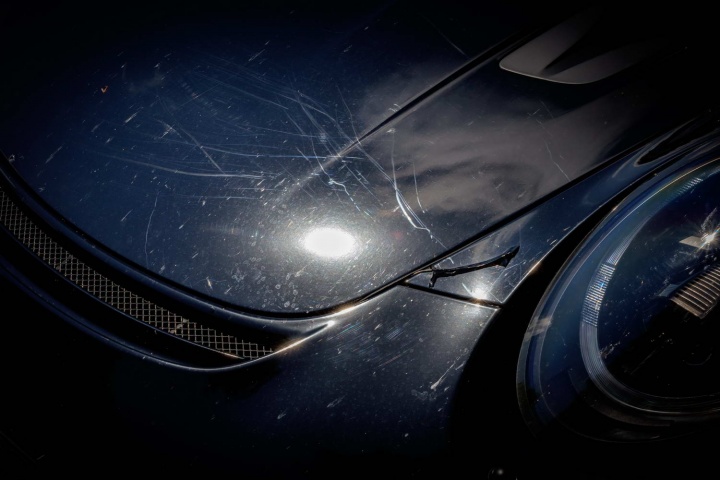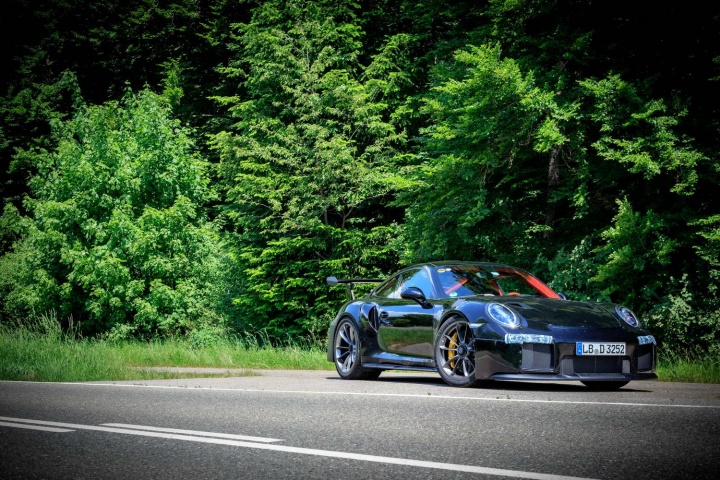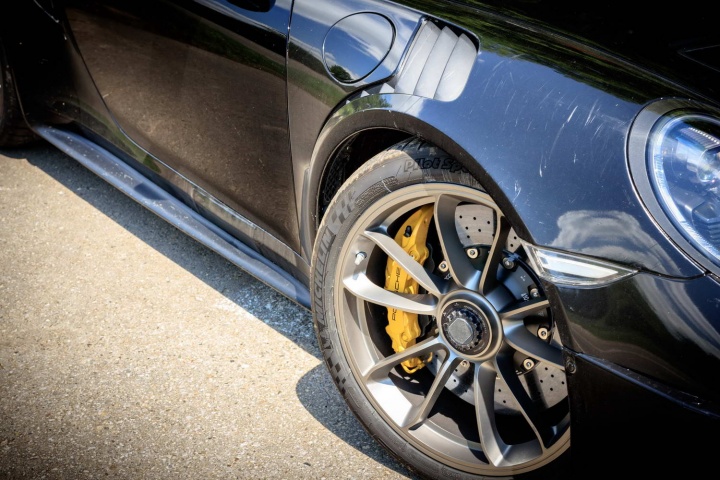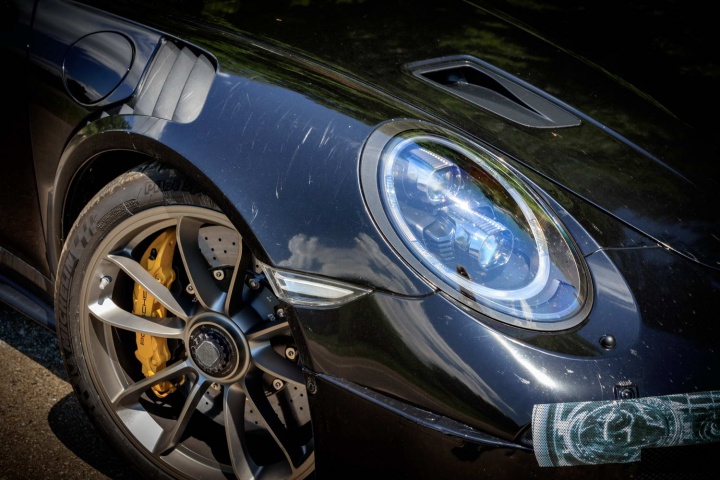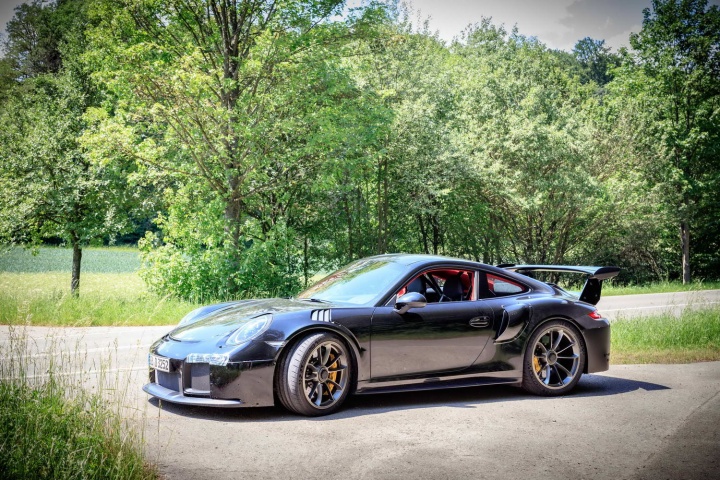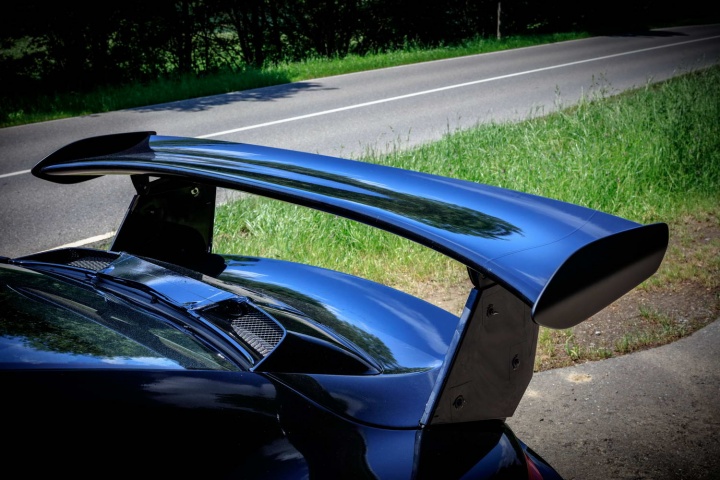As car parks go this one is about as senior as it gets. There's at least four 911 Rs, so many examples of the 911 GT3 RS and 911 GT3 I've stopped counting. I'm in Weissach, Germany. Specifically, the car park of the GT department at Porsche. It's just a week after I had an interesting conversation at another Porsche event with the GT department's model line Director, Andreas Preuninger. There he confirmed the existence of the GT2 RS, a car that's been much rumoured since its predecessor's demise seven years ago. Well, now we know that those rumours are true, and I'm just about to climb into the passenger seat alongside Preuninger himself to see whether it has been worth the wait.
This vehicle is, admits Preuninger, a GT3 RS that's been converted to GT2 RS specification. Under the scarred black disguise there's hints of Lava Orange, one of the 991 GT3 RS's signature launch colours. Preuninger confirms that the GT2 RS will look more extrovert, with bigger air intakes up front, a more prominent front splitter and a lot more exposed carbon fibre. Opt for the Weissach pack and there'll be more still, as the bonnet and roof can be made of the black weave. That, along with magnesium wheels and a lighter titanium roll cage, drops the mass by a further 30kg over the already lightweight standard GT2 RS. Preuninger suggests a kerb weight comfortably under 1,500kg.
He reckons: "it will be a loud car literally, in every sense, it's extrovert, it's look, here I'm coming. I don't say GT2 customers are boastful, that's not the point, but they like a masculine car in appearance, they don't want to hold it back, because it doesn't fit the character of the car. This car is 'here I am, I'm the king, I'm the alpha animal.'"
Giving it the power to match those looks is a development of the 911 Turbo S's 3.8-itre turbocharged flat-six. Porsche is still being cagey about the exact details at this stage, but what Preuninger will admit to is completely redesigned turbochargers with new titanium exhausts, revised internals to cope with the hike in power and a spray-cooled intercooler system that helps generate it. Officially, before the car's unveiling, the GT people are saying 'more than' 650hp is the output. The 700hp that we've heard rumoured then is a certainty, while torque output of 700Nm is likely to be a conservative figure, too.
Unlike its Turbo S relation, the GT2 RS sends all that output to one axle, which means traction issues will keep the 0-100km/h time to around the same 2.9 seconds of a Turbo S. Above that is where the difference will be felt, as the combination of a loss of mass and that greater power creates a more forceful push. Preuninger promises a sub-nine-second sprint to 200km/h from rest and a top speed in excess of 340km/h. That's near hypercar pace.
According to the man himself, the GT2 RS is something of a riposte to a small faction of commentators suggesting that Porsche's GT department has lost focus. By that, he means on outright speed, as the re-introduction of manual cars to the line-up - via the 911 R and gen II GT3 - focuses as much on purity of the driving experience as they do on numbers.
The GT2 RS is all about the numbers, and the goal is to take the Nürburgring lap record off its rivals, which will mean it'll need to do a sub-seven-minute lap. Given a standard GT3 with a circa 200hp deficit in power can manage it in seven minutes and twelve seconds, that looks entirely reasonable. "Everybody is attacking us," says Preuninger, "we were the kings of the Ring, and we will be again." Fairly unambiguous, that.
As is the suspension set up, which is basically 911 Cup Car in Nürburgring specification. Even so, upside down dampers afford it decent ride quality on the road. The RS badge indicates that it'll be PDK-only too, as Preuninger says that RS cars are all about outright performance, and that means the PDK paddle-shifted automatic. It's quicker shifting now, its fitment also allowing the use of an electronically controlled limited slip differential, all to the benefit of performance.
And what performance. Preuninger is busy, but we've a two-hour window to get out in the prototype on the roads around Weissach. The acceleration is laugh-out-loud intense, the force different even to that of the 911 Turbo S. You can feel the lack of mass and it's a physical, intense experience. It's quick everywhere, but the way it pushes deep into three figures on the autobahn is extraordinary, accelerating with the same alacrity regardless of the speed it's already travelling at.
That forceful shove is backed up with a sound that's very reminiscent of early '930' 911 Turbos, the cabin filled with a rich, melodious flat-six sound that's accompanied by the exotic metallic rasp from its titanium exhausts. Even though this is a prototype development car, it feels tight inside, with no nasty vibrations knocks or sounds. With so much power on tap, Porsche didn't feel the need to take out all the sound deadening, which, given the likely price point, makes sense.
Preuninger promises a slightly different GT2 RS to its predecessor, saying: "I like this absolute brutal power that this has, but it's a joy to drive on the track, it's so precise, it's so nimble and agile and a lot easier to drive than a 997 GT2 RS, which was a brute, to the point where you couldn't handle it sometimes, this one has more power, way more power." That much is clear, yet Preuninger says the final 20 per cent of tuning is done in the next month or so.
One thing is certain, the production car promises to live up to its haloed badge. And some. We can't wait to experience it again, only this time at the wheel.

